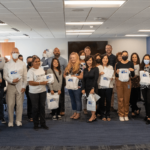Search
Racial Equity & Housing in the Bay Area
October 21, 2020
Homelessness has been on the rise for decades and there are more than 32,000 homeless individuals in the Bay Area. According to Housing and Urban Development’s 2019 Point in Time Count, whites comprise 43% of the general population in Alameda County and 31% of those homeless while African Americans comprise 11% of the general population and constitute 47% of the homeless. This statistic illustrates the racial inequities that exist within Bay Area housing, rooted in systemic policies that disproportionately affect people of color. The emergence of the COVID-19 pandemic further exacerbates these racial inequities in housing in the Bay Area and across the country.
In our recent webinar, Racial Equity & Housing in the Bay Area, hosted by UWBA’s Women United—our partner, Poncho Guevara, Executive Director of Sacred Heart Community Service, discussed the region’s history of exclusionary practices. Dating back to the 1800’s, these practices led to creating rent-burdened households. He showed how these practices are “not natural nor the result of preference or individual actions” but the result of racist policies, including exclusionary zoning, racially restrictive bylaws, racialized public housing, and redlining of Bay Area neighborhoods.
Guevara was joined in the webinar by Laura Escobar, United Way Bay Area Director of Safety Net Services who has worked on homelessness prevention for over 30 years. Escobar discussed UWBA’s Emergency Food and Shelter program and SparkPoint, which have provided a safety net for Bay Area residents in need. Of the more than 250,000 individuals served by UWBA programs, 82% identify as people of color. UWBA’s Emergency Food and Shelter Program has distributed $71 million to support nonprofit organizations across the Bay Area.
To learn more, watch the webinar below.


